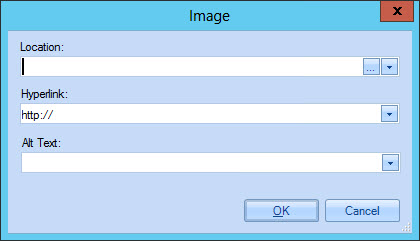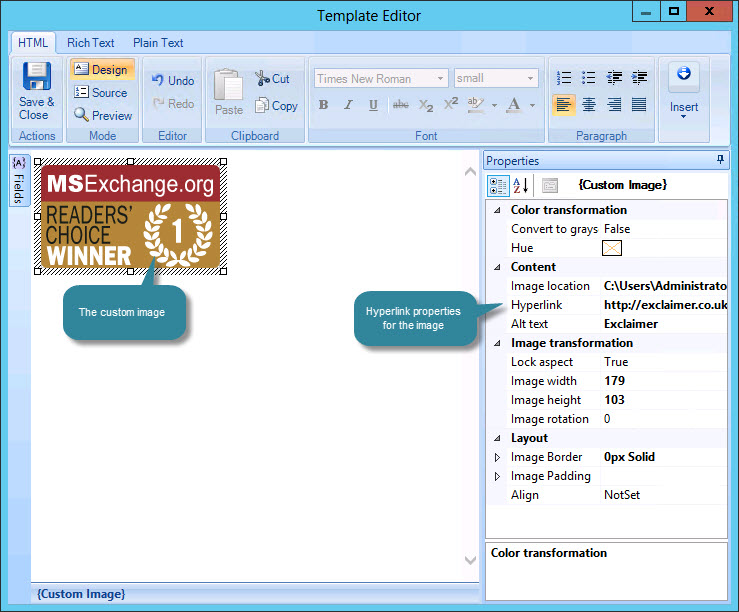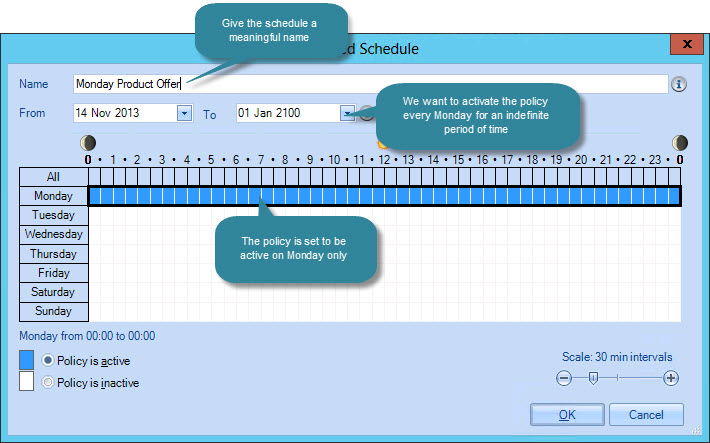How do I insert a web style banner ad that alternates daily?
There may be times where you wish to include a banner ad in signatures (i.e. a banner image which, when clicked by the recipient, links to a web page) but where the banner image and its associated hyperlink should change on a daily basis. In this instance, you need to control which offers are displayed on particular days of the week, for an indefinite period of time.
To achieve this, you need to create one campaign policy (and an associated template) for each day of the week. Each template will contain the required image and hyperlink and each policy will be set to run on a given day. This process is summarized in two stages, below:
|
If you are running a campaign where a different image is required on a daily basis but each image must link to the same web page then you may wish to consider a different approach - please see How do I add a campaign image that alternates daily?. You can also create more complex banner adverts in an external HTML editor and choose to rotate HTML files rather than images. For further information please see Multi-link HTML ads. |
Stage 1: Add required banner image to campaign templates
Create or edit the required number of campaign templates and insert a custom image field. When you choose to add a custom image, the image window is displayed, so you can associate the image with hyperlink details:

Once inserted, you can select the image and view/update these properties as shown below:

Key properties are summarized below:
|
Property |
Summary |
|
Hyperlink |
Specify the full URL of the web page to be opened when recipients click the banner image in their message. |
|
Alt Text |
Specify text to be displayed if images cannot be displayed in messages (for example, if a recipient has chosen to block images in email messages). |
|
Image Location |
Displays the location of the inserted image. |
You should create one template for each day of the week. As such, you are strongly advised to use meaningful names for the templates - for example 'Monday Product Offer', 'Tuesday Product Offer', etc.
Stage 2: Define campaign policies
-
Select the Outlook campaign policies branch in the console tree.
-
Click the new button from the toolbar to start the new Outlook policy wizard.
-
On the general window, specify a meaningful name for the policy - for example 'Monday Product Offer Campaign'.
Your policy must have a valid name. A valid policy name must be unique and not blank. You should try to make your policy names as descriptive as possible because they are used to uniquely identify the policy in a number of areas. You can also use the policy description to record comments and notes about a policy (such as what it does and under what conditions it triggers). We highly recommend that you use this field to keep a record of changes to a policy over time.
-
Click next to progress with the wizard and choose a campaign template. Select the required campaign template that was created in stage 1 - for example, if you are creating a policy to be run on Mondays, you would select the template which contains relevant content for Mondays.
-
Click next to see a preview of how the selected template will appear in email messages.
-
Click next to continue and set conditions under which this policy will be applied. In this case we want the campaign to be applied to all users therefore select the Outlook user is anyone option.
-
Click next to access date options.
-
Select the use advanced schedule option and then click add to add a new schedule (for further information about these options please see the using the advanced schedule topic).
-
Define the schedule for the required day of the week - for example, Monday:

-
Click OK to return to the new Outlook policy wizard.
-
Click next and then finish to complete the wizard. The new policy is added to the Outlook campaign policies branch of the console tree.
-
Once you have saved changes, the policy is ready for use. It is a good idea to test the policy in the policy tester to ensure that it works as expected.
-
Repeat this process for each day of the week.
For more detailed information about adding policies, see the adding a new policy topic.









